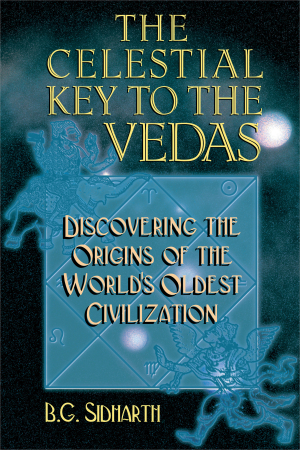The Celestial Key to the Vedas
Discovering the Origins of the World's Oldest Civilization
- Pages: 176
- Book Size: 6 x 9
- ISBN-13: 9780892817535
- Imprint: Inner Traditions
- On Sale Date: October 1, 1999
- Format: Paperback Book
- Illustrations: 11 b&w photographs
A leading astronomer proves that India had a thriving civilization capable of sophisticated astronomy long before Greece, Egypt, or any other world culture.
• Provides conclusive evidence that the Rig Veda is 12,000 years old.
• Establishes actual dates and places for many of the events in the Hindu epics.
For more than a century scholars have debated the antiquity of the Vedas and their related literature, the Brahmanas and Puranas. Relying upon a host of assumptions from linguistic theory, anthropology, and archaeology, they have agreed upon 1500 b.c. as the earliest possible date for the Rig Veda, itself the oldest extant example of Indo-European literature. But in this groundbreaking book, astronomer B. G. Sidharth proves conclusively that the earliest portions of the Rig Veda can be dated as far back as 10,000 B.C.
By deciphering the astronomical events and alignments contained in mythical and symbolic form in these ancient texts, Sidharth calls into question many if not all of the assumptions governing Indo-European prehistory. He explores such subjects as the astronomical significance of many Hindu deities and myths, the system of lunar asterisms used to mark time, the identity of the Asvins, and the sophisticated calendar of the ancients that harmonized solar and lunar cycles. Sidharth provides incontrovertible evidence that such "advanced" astronomical concepts as precession, heliocentrism, and the eclipse cycle are encoded in these ancient texts, passages of which make perfect sense only if these astronomical keys are known. Based on internal evidence in the Mahabharata and Ramayana, he also becomes the first to establish likely dates--and even places--for the events described in these famous epics. The Celestial Key to the Vedas is sure to astonish anyone concerned with astronomy, India, or the roots of civilization.
Introduction
1. The Case for Indian Astronomy
2. The Astronomy of the Hindus
3. The Heliocentric Theory in the Rg Veda
4. Astronomy in the Rg Veda
5. The Unmythical Puranas: A Study in Reverse Symbolism
6. Brahma's Day: The Great Cosmic Cycle and the Age of the Rg Veda
7. The Antiquity of the Rg Veda
8. A Lost Anatolian Civilization--Is It Vedic?
9. Calendric Astronomy, Astronomic Dating, and Archaeology: A New View of Antiquity and Its Science
10. Vishnu as an Astronomical Symbol from the Vedas to the Puranas
11. A Date and Place for the Mahabharata
12. Astronomy, Symbolism, and Ancient Indian Chronology: A Date for the Ramayana
13. The Indus Civilization--An Astronomical Perspective
Glossary
Notes
Photographs
Index
The Celestial Key to the Vedas succeeds in shattering the time frame through which all Indo-European literature has been previously measured. With astonishing new evidence, author B. G. Sidharth proves that the earliest portions of the R. g Veda, the world’s oldest sacred teachings, can be dated back as far as 10,000 B.C. For more than a century scholars have debated the antiquity of Indian culture and the Vedas; relying upon a host of Eurocentric assumptions, they regard 1500 B.C. as the earliest possible date for the writing of the R. g Veda. Sidharth stands this belief on its head, revealing why the Vedas are, in fact, nearly eight-and-a-half millennia older.
Sidharth provides incontrovertible evidence that such advanced “European” astronomical concepts as precession, heliocentrism, and the eclipse cycle were first discovered and encoded in these ancient Indian texts, passages of which make perfect sense only if their astronomical keys are known.And by deciphering the astronomical events and alignments contained in mythical and symbolic form in these ancient texts, he uncovers the key and calls into question many--if not all--of the assumptions governing Indo-European prehistory. He explores such subjects as the astronomical significance of Hindu deities and myths, the system of lunar asterisms used to mark time, the identity of the A´svins, and the sophisticated calendar of the ancients that harmonized solar and lunar cycles. Using internal evidence from the Maha-bha-rata and Ra-ma-yan. a, he also becomes the first to establish likely dates--and even places--for the events described in these famous epics. The Celestial Key to the Vedas is a groundbreaking book, one that is sure to astonish anyone interested in astronomy, spirituality, India, or the origins of science and civilization.
DR. B. G. SIDHARTH is director of India’s B. M. Birla Science Center.He has over thirty years of experience in astronomy and science education and is a frequent consultant to astronomy journals and science centers around the globe.He lives in Hyderabad, India.



